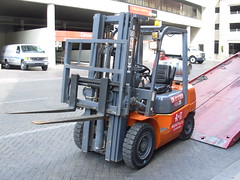A guy from my grad class died after being hit by a forklift a few years ago.
Back in elementary school, he was one of the rowdier boys on the playground. Once, at the paperboy shack, he put my little brother’s stack of newspapers in dog poo, then apologized for it at a pub 20 years later. Shortly after, we heard he’d died.
Protecting workers near mobile equipment
I thought about my old classmate when I read about a “proximity detector” in a newsletter from WorkSafeBC’s Research Secretariat, which is funding part of this project by Pro-Active Safety Systems Technology Inc.
“You get no second chance with mobile equipment,” said co-inventor Richard Shervey, an industrial electrician. “There’s no crumple zones and they’re made out of solid steel. When they hit you, most of the time the worst happens. All it takes is one second of inattention.”
Each year more than 1,000 workers in BC are injured or killed in incidents involving forklifts and other mobile equipment like log loaders, bulldozers, and backhoes.
How does it work?
PSST mounts its sensing device into the machine and builds sensors into workers’ high-visibility vests.
“The system is able to quickly and accurately measure the proximity of people, objects and vehicles within the workplace,” reads the PSST web site. “These real-time proximity measurements are then used to trigger warnings to both workers and vehicle operators when safety zones have been breached.”
A later version of the product will stop the machine automatically if the pedestrian fails to move out of the way.
Industry partners needed for pilot projects
A safety device like this requires extensive testing. It’s not like a piece of software that can be released with bugs and fixed later. They have to get it right from the start.
“If our thing doesn’t work, somebody could die,” Richard said. “We want to make sure the system works perfectly before we would ever sell them.”
PSST is looking for partners in industry to pilot the device at their worksites.
“If they were willing to pick up a bit of the tab for our cost to install it on their machines, then we could come and monitor it and do a pilot project on site for a month,” said Richard. “We’re going to find things we have to fix before we get into retail sales.”
I was especially impressed to hear PSST is based out of one of the world’s most advanced radio research labs: the Dominion Radio Astrophysical Observatory in Penticton – part of the National Research Council of Canada.
Check out this demo of “The Magic Forklift” in action on YouTube.



